Variation of Ionospheric Narrowband and Wideband Performance for a 12,760 km Transequatorial Link and Its Dependence on Solar and Ionospheric Activity
Abstract
1. Introduction
2. System Hardware Description
3. Channel Sounding
3.1. Narrowband Metrics
3.2. Wideband Metrics
4. Results
4.1. Aggregated Results Depending on Solar Activity
4.2. Delay, Doppler and Number of Paths Per Campaign
4.3. Delay, Doppler and Number of Paths vs Narrowband FLA
4.4. Effects of Ionospheric Irregularities on Wideband Sounding
5. Conclusions
Author Contributions
Funding
Acknowledgments
Conflicts of Interest
Abbreviations
| ADC | Analog-to-digital converter |
| DAC | Digital-to-analog converter |
| EPB | Equatorial plasma bubbles |
| FLA | Frequency of large availability |
| GNSS | Global Navigation Satellite System |
| GPS | Global Positioning System |
| HF | High frequency |
| IGS | International GNSS Service |
| NLOS | Non-Line-of-Sight |
| OCXO | Oven controlled crystal oscillator |
| OE | Observatori de l’Ebre |
| PN | Pseudo noise |
| SNR | Signal-to-noise ratio |
| SSN | Sun spot number |
| UTC | Coordinated Universal Time |
| VHF | Very high frequency |
References
- Rishbeth, H.; Garriott, O.K. Introduction to Ionospheric Physics; Academic Press: New York, NY, USA, 1969. [Google Scholar]
- Angling, M.; Shaw, J.; Shukla, A.; Cannon, P. Development of an HF selection tool based on the Electron Density Assimilative Model near-real-time ionosphere. Radio Sci. 2009, 44. [Google Scholar] [CrossRef]
- Forbes, J.M.; Palo, S.E.; Zhang, X. Variability of the ionosphere. J. Atmos. Sol. Terr. Phys. 2000, 62, 685–693. [Google Scholar] [CrossRef]
- Rishbeth, H.; Mendillo, M. Patterns of F2-layer variability. J. Atmos. Sol. Terr. Phys. 2001, 63, 1661–1680. [Google Scholar] [CrossRef]
- Altadill, D.; Apostolov, E. Time and scale size of planetary wave signatures in the ionospheric F region: Role of the geomagnetic activity and mesosphere/lower thermosphere winds. J. Geophys. Res. 2003, 108. [Google Scholar] [CrossRef]
- Altadill, D.; Apostolov, E.M.; Boska, J.; Lastovicka, J.; Sauli, P. Planetary and gravity wave signatures in the F-region ionosphere with impacton radio propagation predictionsand variability. Ann. Geophys. 2004, 47, n.2/3. [Google Scholar]
- Huang, C.S.; de La Beaujardiere, O.; Roddy, P.A.; Hunton, D.E.; Liu, J.Y.; Chen, S.P. Occurrence probability and amplitude of equatorial ionospheric irregularities associated with plasma bubbles during low and moderate solar activities (2008–2012). J. Geophys. Res. 2014, 119, 1186–1199. [Google Scholar] [CrossRef]
- Woodman, R. Spread F—An old equatorial aeronomy problem finally resolved? In Annales Geophysicae; Copernicus GmbH: Göttingen, Germany, 2009; Volume 27, pp. 1915–1934. [Google Scholar]
- Booker, H.; Wells, H. Scattering of radio waves by the F-region of the ionosphere. Terr. Magn. Atmos. Electr. 1938, 43, 249–256. [Google Scholar] [CrossRef]
- Hervás, M.; Alsina-Pagès, R.M.; Orga, F.; Altadill, D.; Pijoan, J.L.; Badia, D. Narrowband and wideband channel sounding of an Antarctica to Spain ionospheric radio link. Remote Sens. 2015, 7, 11712–11730. [Google Scholar] [CrossRef]
- Vilella, C.; Miralles, D.; Pijoan, J. An Antarctica-to-Spain HF ionospheric radio link: Sounding results. Radio Sci. 2008, 43, 1–17. [Google Scholar] [CrossRef]
- Ostrow, S.; PoKempner, M. The differences in the relationship between ionospheric critical frequencies and sunspot number for different sunspot cycles. J. Geophys. Res. 1952, 57, 473–480. [Google Scholar] [CrossRef]
- Clette, F. Sunspot Index and Long-Term Solar Observations. Available online: http://www.sidc.be/silso/home (accessed on 2 May 2019).
- Clette, F.; Cliver, E.; Lefèvre, L.; Svalgaard, L.; Vaquero, J. Revision of the sunspot number (s). Adv. Space Res. 2015, 13, 529–530. [Google Scholar] [CrossRef]
- Angling, M.J.; Davies, N.C. An assessment of a new ionospheric channel model driven by measurements of multipath and Doppler spread. In Proceedings of the IEE Colloquium on Frequency Selection and Management Techniques for HF Communications, London, UK, 29–30 March 1999; pp. 4/1–4/6. [Google Scholar] [CrossRef]
- Orga, F.; Altadill, D.; Hervás, M.; Alsina-Pagès, R.M. Interannual Variation of a 12,760 km Transequatorial Ionospheric Channel Availability and Its Dependence on Ionization. In Proceedings of the 1st International Electronic Conference on Atmospheric Sciences (ECAS 2016), Basel, Switzerland, 16–31 July 2016. [Google Scholar]
- Pijoan, J.L.; Altadill, D.; Torta, J.M.; Alsina-Pagès, R.M.; Marsal, S.; Badia, D. Remote geophysical observatory in Antarctica with HF data transmission: A review. Remote Sens. 2014, 6, 7233–7259. [Google Scholar] [CrossRef]
- Ads, A.; Bergadà, P.; Vilella, C.; Regué, J.; Pijoan, J.; Bardají, R.; Mauricio, J. A comprehensive sounding of the ionospheric HF radio link from Antarctica to Spain. Radio Sci. 2013, 48, 1–12. [Google Scholar] [CrossRef]
- Xilinx Inc. 3rd Party Xilinx Platforms. Available online: http://www.xilinx.com/products/boards-and-kits/do-di-dsp-dk4-sg-uni-g.html (accessed on 5 February 2019).
- Sgcworld.com. SG-235 Smartuner. Available online: http://www.sgcworld.com/235ProductPage.html (accessed on 2 May 2019).
- Alsina-Pagès, R.M.; Hervás, M.; Orga, F.; Pijoan, J.L.; Badia, D.; Altadill, D. Physical layer definition for a long-haul HF Antarctica to Spain radio link. Remote Sens. 2016, 8, 380. [Google Scholar] [CrossRef]
- Davies, K. Ionospheric Radio Propagation; US Department of Commerce, National Bureau of Standards: Washington, DC, USA, 1965; Volume 80.
- Golomb, S.W. Shift Register Sequences; Aegean Park Press: Laguna Hills, CA, USA, 1982. [Google Scholar]
- Goodman, J.; Ballard, J.; Sharp, E. A long-term investigation of the HF communication channel over middle-and high-latitude paths. Radio Sci. 1997, 32, 1705–1715. [Google Scholar] [CrossRef]
- Cooley, J.; Tukey, J. An algorithm for the machine calculation of complex Fourier series. Math. Comput. 1965, 19, 297–301. [Google Scholar] [CrossRef]
- Kaiser, J. A Family of Window Functions Having Nearly Ideal Properties; Memorandum, Bell Telephone Laboratories: Murray Hill, NJ, USA, 1964. [Google Scholar]
- Proakis, J.G. Digital Communications Fourth Edition, 2001; McGraw-Hill Companies, Inc.: New York, NY, USA, 1998. [Google Scholar]
- Warrington, E.M.; Stocker, A. Measurements of the Doppler and multipath spread of HF signals received over a path oriented along the midlatitude trough. Radio Sci. 2003, 38, 1. [Google Scholar] [CrossRef]
- Adv Space Res. National Centers for Environmental Information of the NOAA. Available online: http://www.ngdc.noaa.gov/stp/spaceweather.html (accessed on 15 April 2019).
- Larsen, R.D. Box-and-whisker plots. J. Chem. Educ. 1985, 62, 302. [Google Scholar] [CrossRef]
- Adebesin, B.O.; Rabiu, A.B.; Adeniyi, J.O.; Amory-Mazaudier, C. Nighttime morphology of vertical plasma drifts at Ouagadougou during different seasons and phases of sunspot cycles 20–22. J. Geophys. Res. Space Phys. 2015, 120, 10020–10038. [Google Scholar] [CrossRef]
- Magdaleno, S.; Altadill, D.; Herraiz, M.; Blanch, E.; de La Morena, B. Ionospheric peak height behavior for low, middle and high latitudes: A potential empirical model for quiet conditions—Comparison with the IRI-2007 model. J. Atmos. Sol. Terr. Phys. 2011, 73, 1810–1817. [Google Scholar] [CrossRef]
- Magdaleno, S.; Herraiz, M.; Altadill, D.; Benito, A. Climatology characterization of equatorial plasma bubbles using GPS data. J. Space Weather Space Clim. 2017, 7, A3. [Google Scholar] [CrossRef]
- Blanch, E.; Altadill, D.; Juan, J.; Camps, A.; Barbosa, J.; González-Casado, G.; Riba, J.; Sanz, J.; Vazquez, G.; Orús-Pérez, R. Improved characterization and modeling of equatorial plasma depletions. J. Space Weather Space Clim. 2018, 8, A38. [Google Scholar] [CrossRef]
- McNamara, L.; Caton, R.; Parris, R.; Pedersen, T.; Thompson, D.; Wiens, K.; Groves, K. Signatures of equatorial plasma bubbles in VHF satellite scintillations and equatorial ionograms. Radio Sci. 2013, 48, 89–101. [Google Scholar] [CrossRef]
- Cohen, R.; Bowles, K.L. Ionospheric VHF scattering near the magnetic equator during the International Geophysical Year. J. Res. Natl. Bur. Stand. US Sect. D 1963, 67, 459–480. [Google Scholar] [CrossRef]
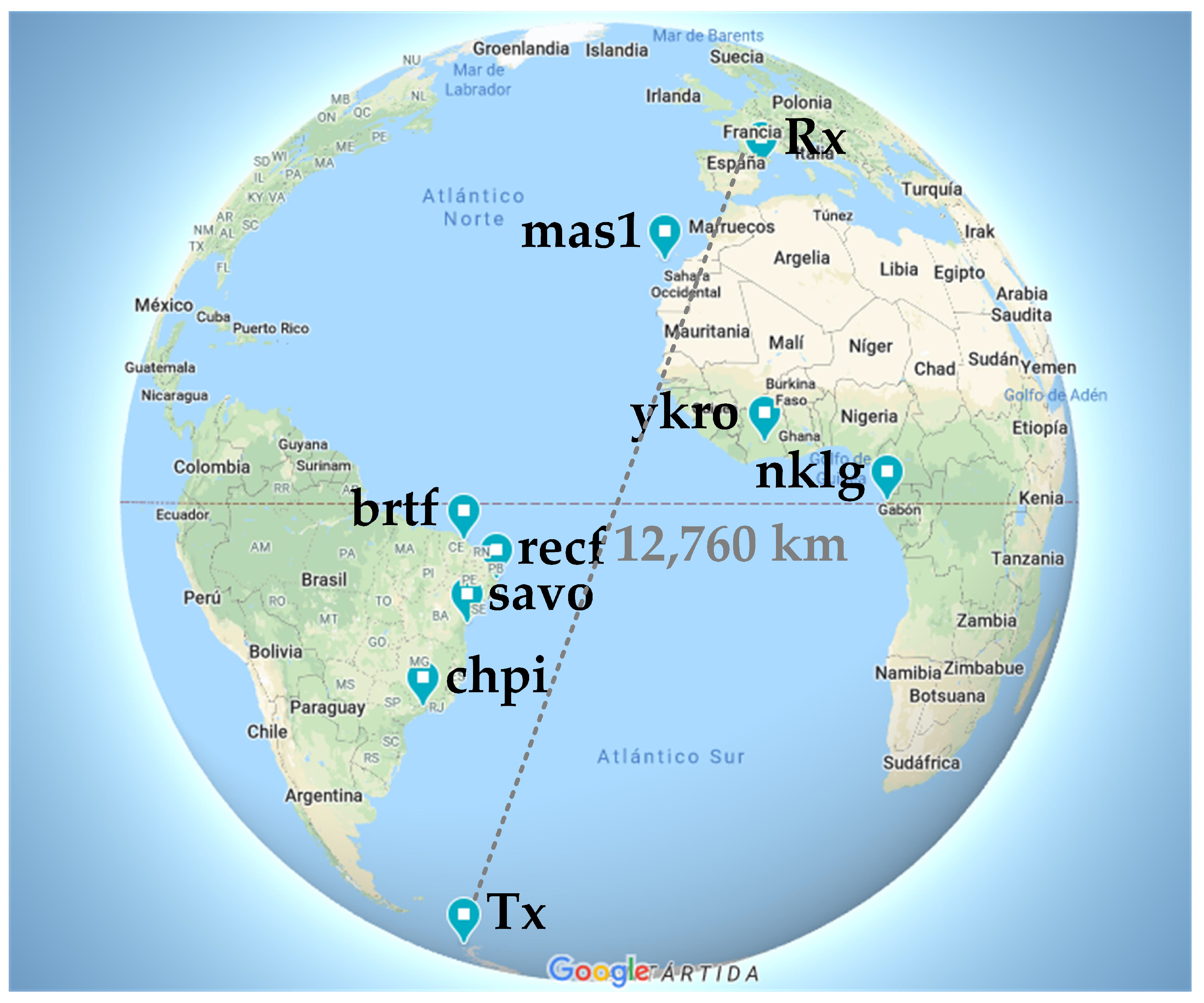
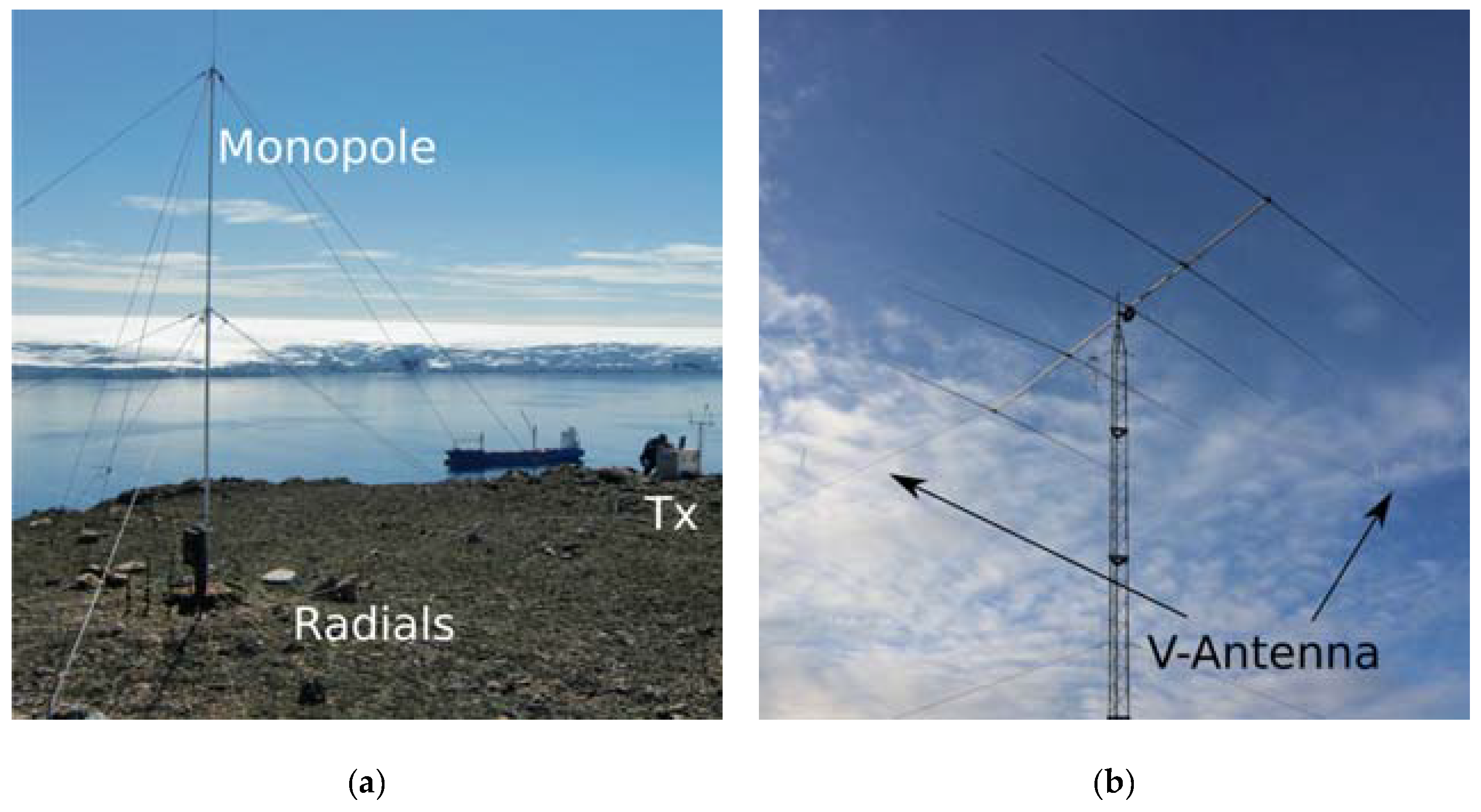



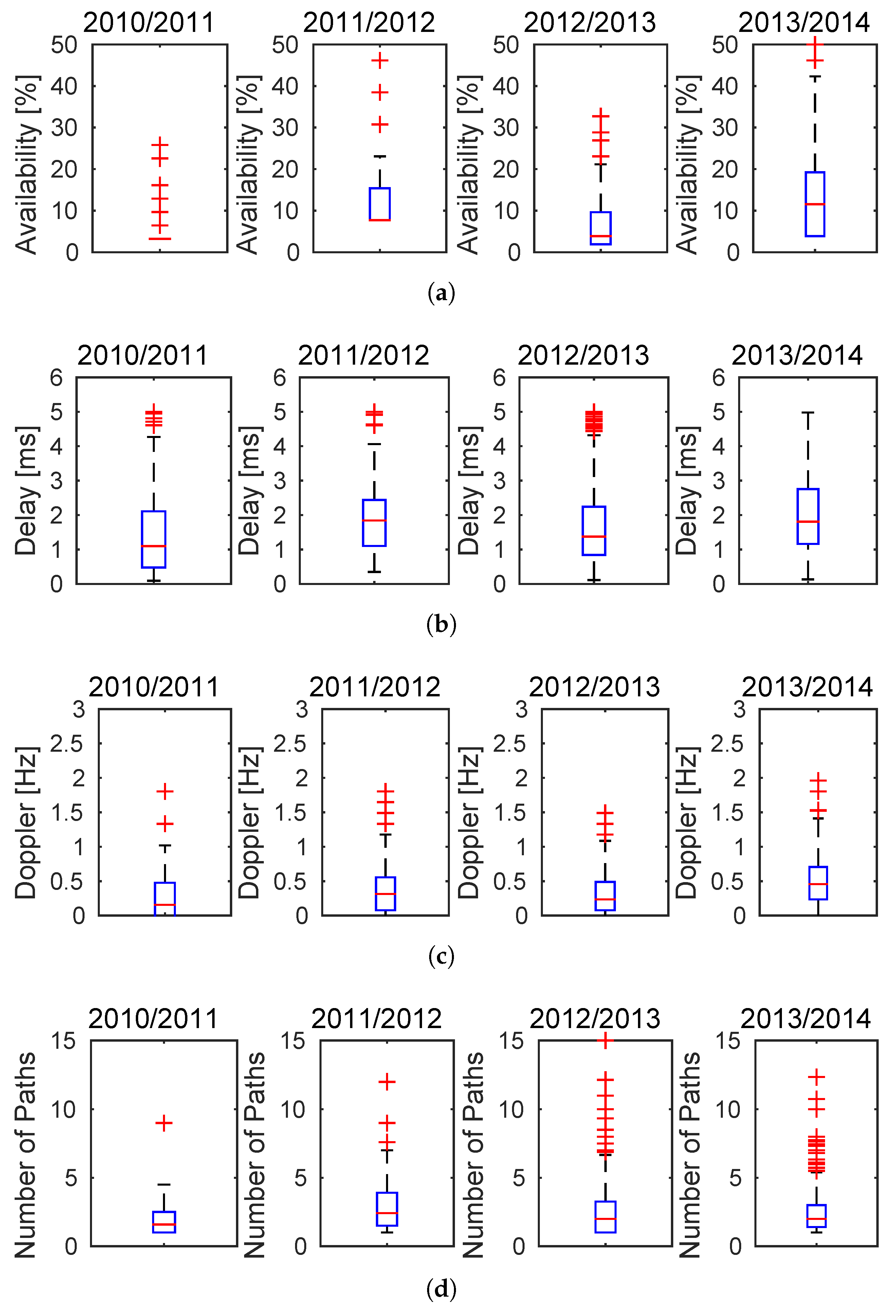
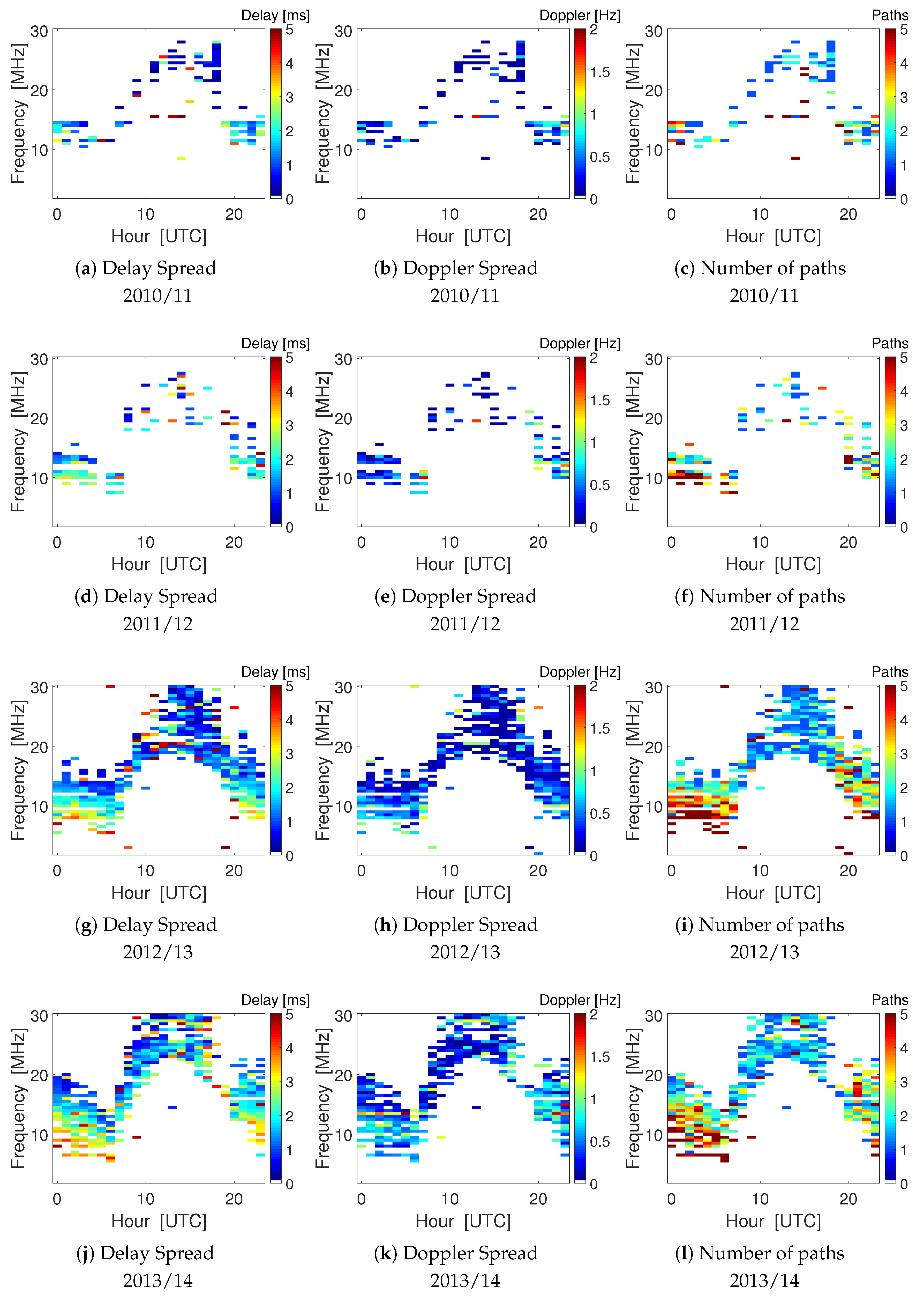

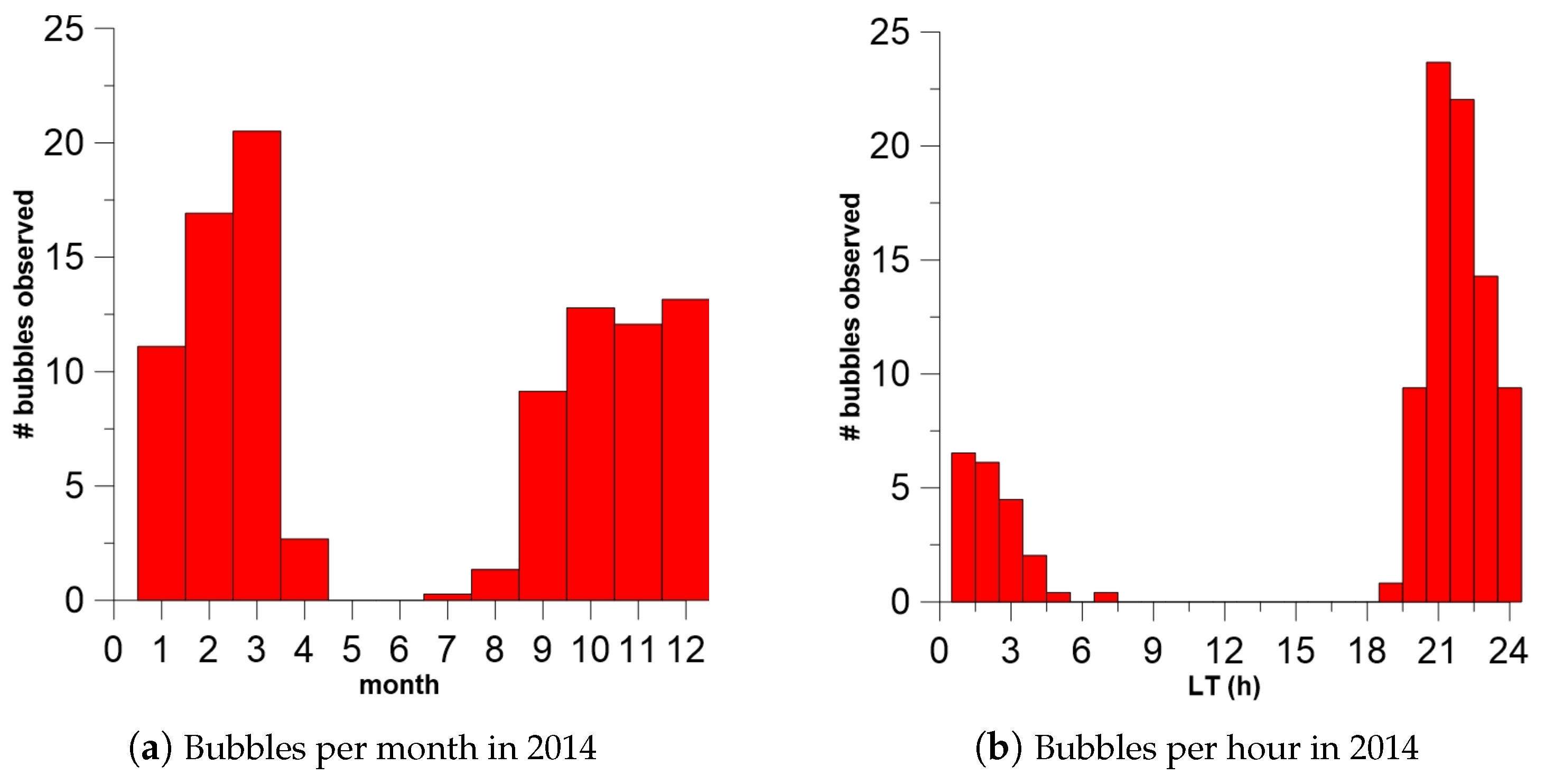
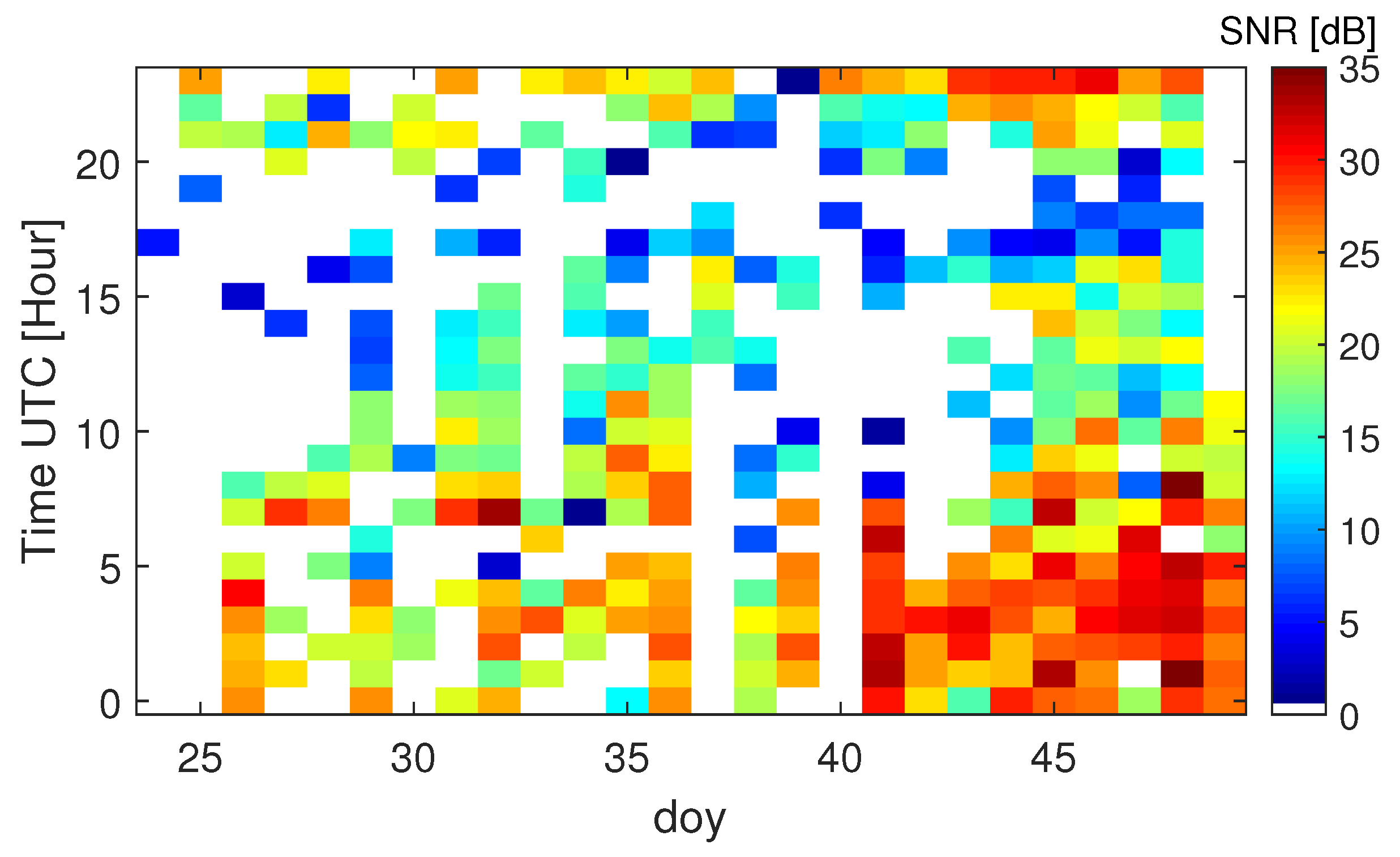
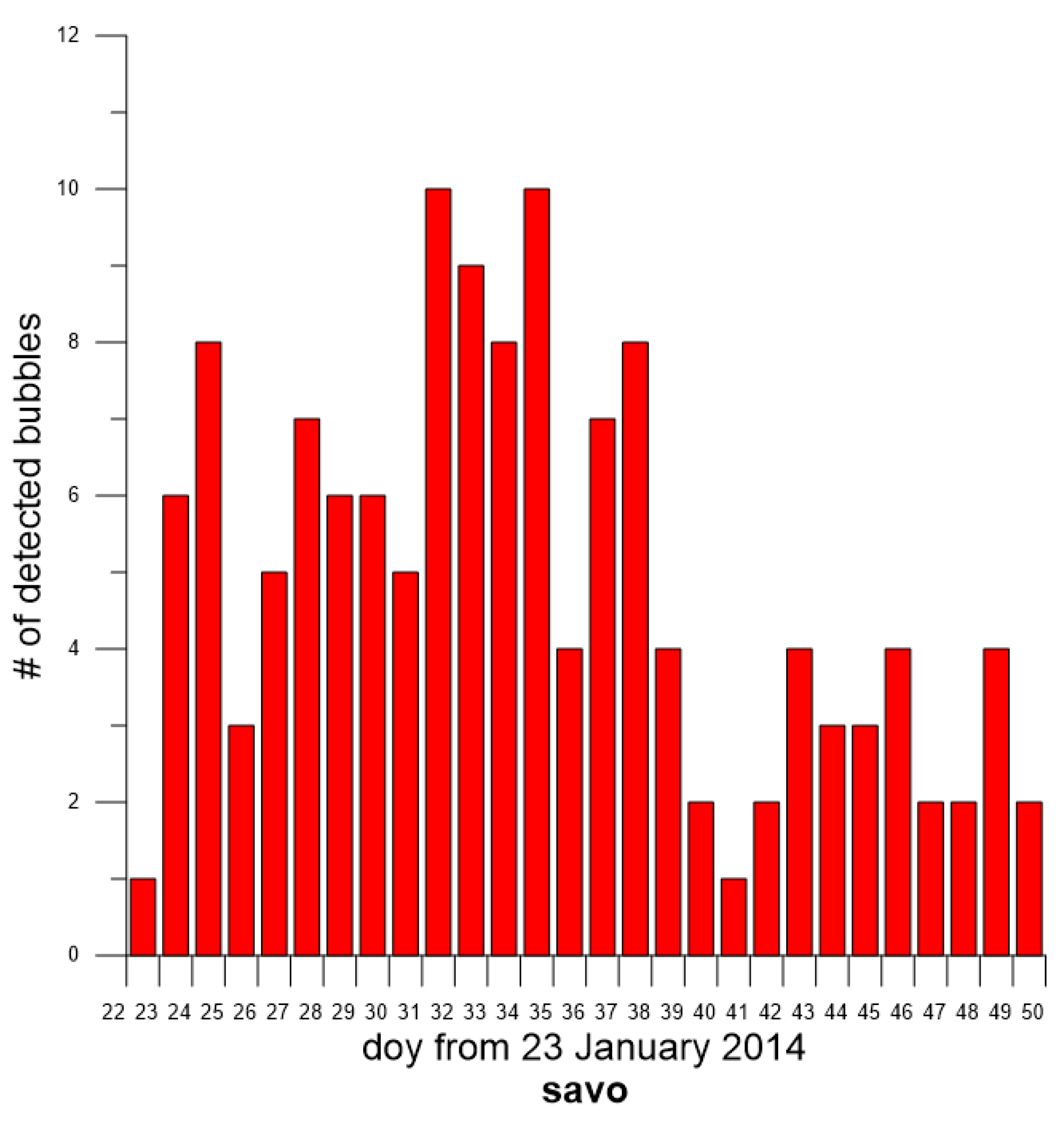
| Survey | Start Date | End B | # Days | # Total Files | # Avail. Files (%) Files | Avail. | Averaged SSN |
|---|---|---|---|---|---|---|---|
| 2010/2011 | 22/1/2011 | 1/3/2011 | 39 | 53,352 | 2719 | 5.1 | 42 |
| 2011/2012 | 13/2/2012 | 25/2/2012 | 13 | 17,784 | 2476 | 13.92 | 56 |
| 2012/2013 | 5/1/2013 | 24/02/2013 | 51 | 69,768 | 17,268 | 24.75 | 78 |
| 2013/2014 | 24/1/2014 | 18/2/2014 | 26 | 35,568 | 17,729 | 49.85 | 123 |
© 2020 by the authors. Licensee MDPI, Basel, Switzerland. This article is an open access article distributed under the terms and conditions of the Creative Commons Attribution (CC BY) license (http://creativecommons.org/licenses/by/4.0/).
Share and Cite
Alsina-Pagès, R.M.; Altadill, D.; Hervás, M.; Blanch, E.; Segarra, A.; Gonzalez Sans, X. Variation of Ionospheric Narrowband and Wideband Performance for a 12,760 km Transequatorial Link and Its Dependence on Solar and Ionospheric Activity. Remote Sens. 2020, 12, 2750. https://doi.org/10.3390/rs12172750
Alsina-Pagès RM, Altadill D, Hervás M, Blanch E, Segarra A, Gonzalez Sans X. Variation of Ionospheric Narrowband and Wideband Performance for a 12,760 km Transequatorial Link and Its Dependence on Solar and Ionospheric Activity. Remote Sensing. 2020; 12(17):2750. https://doi.org/10.3390/rs12172750
Chicago/Turabian StyleAlsina-Pagès, Rosa Ma, David Altadill, Marcos Hervás, Estefania Blanch, Antoni Segarra, and Xavier Gonzalez Sans. 2020. "Variation of Ionospheric Narrowband and Wideband Performance for a 12,760 km Transequatorial Link and Its Dependence on Solar and Ionospheric Activity" Remote Sensing 12, no. 17: 2750. https://doi.org/10.3390/rs12172750
APA StyleAlsina-Pagès, R. M., Altadill, D., Hervás, M., Blanch, E., Segarra, A., & Gonzalez Sans, X. (2020). Variation of Ionospheric Narrowband and Wideband Performance for a 12,760 km Transequatorial Link and Its Dependence on Solar and Ionospheric Activity. Remote Sensing, 12(17), 2750. https://doi.org/10.3390/rs12172750







